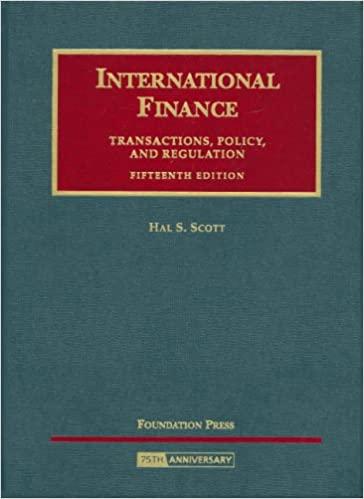Question
Remember, not only did you contribute to Social Security but your employer did too. It totaled 15% of your income before taxes. If you averaged
Remember, not only did you contribute to Social Security but your employer did too. It totaled 15% of your income before taxes. If you averaged only $30K over your working life, that's close to $220,500.
If you calculate the future value of $4,500 per year (yours & your employer's contribution) at a simple 5% (less than what the govt. pays on the money that it borrows), after 49 years of working you'd have $892,919.98.
If you took out only 3% per year, you'd receive $26,787.60 per year and it would last better than 30 years (until you're 95 if you retire at age 65) and that's with no interest paid on that final amount on deposit! If you bought an annuity and it paid 4% per year, you'd have a lifetime income of $2,976.40 per month.
Washington has pulled off a bigger Ponzi scheme than Bernie Madoff.
Entitlement?? NOT!!! I paid cash for my social security insurance!!!! Just because they borrowed the money, doesn't make my benefits some kind of charity or handout!!
Congressional benefits ---- free healthcare, outrageous retirement packages, 67 paid holidays, three weeks paid vacation, unlimited paid sick days, now that's welfare, and they have the nerve to call my social security retirement entitlements?
They call SS and Medicare an entitlement even though most of us have been paying for it all our working lives and now when it's time for us to collect, the government is running out of money. Why did the government borrow from it in the first place? Imagine if the *GOVERNMENT* gave 'US' the same support they give to other countries.
Sad isn't it?
99% of people won't have the guts to forward this.
I'm one of the 1% -- I Just Did.
You have been hired by the AARP to write a report that looks into the merit of the above analysis.
1) Address the mathematical consistency of the assertions made in steps 1) through 4). If you find any inconsistencies please state and explain them.
2) One member of the AARP group reaching out to you recently retired at age 65 after 40 years of work where he averaged roughly $30,000 per year. His Social Security Taxable Income is given in Table 1 on the next page. Using the assumptions about Social Security made in the email analysis, calculate the current value of his Social Security Contributions and whether it can support 30 years of annual Social Security Income of $26,787.60 (without interest paid on the current amount of deposit). If not,
a) Explain the difference between this portfolio and the one in the above analysis.
b) Assuming a 5% return on current monies in the Social Security Account and a 30 year payout period, how much annual payout could this portfolio support?
3) Look up how much Social Security would actually pay each of the 2 people described above.
4) Based on all of the above, what is your conclusion as to the merits of calling Social Security and entitlement.
5) The above email claims a 15% combined contribution to Social Security by both employee and employer and 5% yearly interest rate on money in the fund.. Check to see whether these numbers are historically correct. If not, using the correct values recalculate the numbers for the AARP member in Table 1.
6) Based on current interest rates, is an assumption of 5% on Social Security funds realistic? If not, recalculate using what you consider to be a realistic interest rate.
|
| Social Security |
| Year | Salary |
| 1972 | $ 4,121.40 |
| 1973 | $ 4,680.00 |
| 1974 | $ 5,400.00 |
| 1975 | $ 6,480.00 |
| 1976 | $ 7,920.00 |
| 1977 | $ 8,069.40 |
| 1978 | $ 9,180.00 |
| 1979 | $ 9,900.00 |
| 1980 | $ 10,620.00 |
| 1981 | $ 13,740.00 |
| 1982 | $ 15,540.00 |
| 1983 | $ 17,075.40 |
| 1984 | $ 19,440.00 |
| 1985 | $ 21,420.00 |
| 1986 | $ 22,680.00 |
| 1987 | $ 23,760.00 |
| 1988 | $ 25,200.00 |
| 1989 | $ 26,280.00 |
| 1990 | $ 27,000.00 |
| 1991 | $ 28,800.00 |
| 1992 | $ 30,780.00 |
| 1993 | $ 32,040.00 |
| 1994 | $ 33,300.00 |
| 1995 | $ 34,560.00 |
| 1996 | $ 36,360.00 |
| 1997 | $ 36,720.00 |
| 1998 | $ 37,620.00 |
| 1999 | $ 39,240.00 |
| 2000 | $ 41,040.00 |
| 2001 | $ 43,560.00 |
| 2002 | $ 45,720.00 |
| 2003 | $ 48,240.00 |
| 2004 | $ 50,940.00 |
| 2005 | $ 52,200.00 |
| 2006 | $ 52,740.00 |
| 2007 | $ 54,000.00 |
| 2008 | $ 56,520.00 |
| 2009 | $ 58,500.00 |
| 2010 | $ 61,200.00 |
| 2011 | $ 64,080.00 |
Step by Step Solution
There are 3 Steps involved in it
Step: 1

Get Instant Access to Expert-Tailored Solutions
See step-by-step solutions with expert insights and AI powered tools for academic success
Step: 2

Step: 3

Ace Your Homework with AI
Get the answers you need in no time with our AI-driven, step-by-step assistance
Get Started


